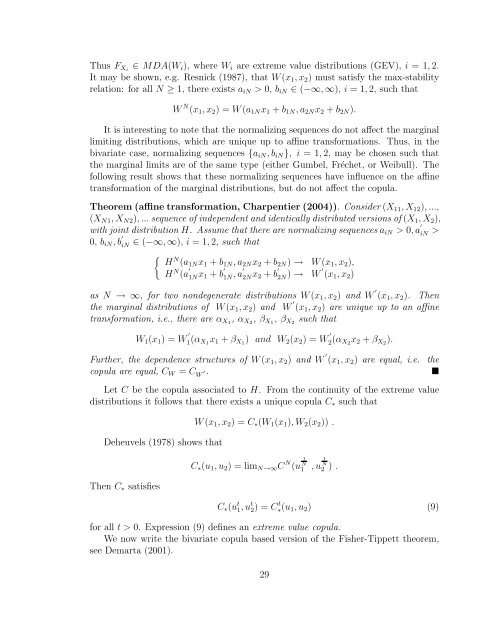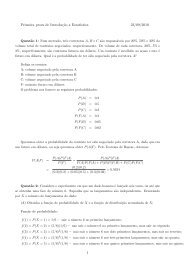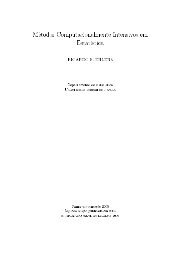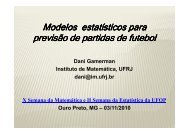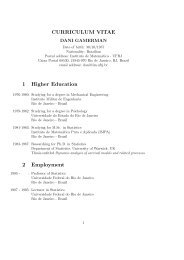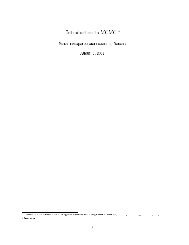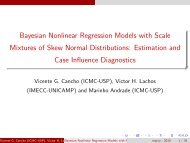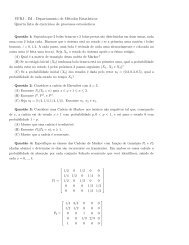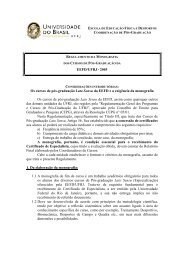such thatC(u; v) =© ru;v¡© ¡1 (u); © ¡1 (v) ¢ : (8)Note that the last theorem does not states that every copula C can be representedby a Gaussian copula, but that for each pair (u; v) 2 [0; 1] 2 always exist a memberof the family of the Gaussian copulas for which (8) holds whenever (7) is true. Infact, r u;v de¯ned by (7) is another local dependence measure related to the distancebetween the copula C <strong>and</strong> the Gaussian copula in [0; 1] 2 .4 Extreme value copulas <strong>and</strong> applicationsExtreme value multivariate modelling presents special features which rule out membersof the most well known general family of distributions, the elliptical family. Thevariables involved are usually non-exchangeable, positively associated (if not independent),with non-linear forms of dependence. In applications, additional complicationsarise from the usual scarcity of data.The asymptotic theory for extremes is well developed <strong>and</strong> univariate modelling basicallyfalls in one of the two categories: modelling st<strong>and</strong>ardized maxima through thegeneralized extreme value distribution (GEV), or modeling excesses over high thresholdsvia the generalized Pareto distribution (GPD). In the multivariate case thereare analogs of the two approaches, which follow from extensions of the Fisher <strong>and</strong>Tippett theorem, e.g. Fisher <strong>and</strong> Tippett (1928). However, the limit family has no¯nite parameterization, see Galambos (1978), Joe (1997), Reiss <strong>and</strong> Thomas (1997)<strong>and</strong> Coles (2001). It is possible to characterize sub-families of multivariate extremevalue distributions by assuming extreme value models for the margins <strong>and</strong> specifyingparametric models for the dependence function, see Pick<strong>and</strong>s (1981), Deheuvels(1978), de Haan (1985) <strong>and</strong> Tawn (1988), among others.The classical results in extreme value theory may be rewritten in terms of copulas.Let (X i;1 ;X i;2 ), i =1; 2;:::, be a sequence of r<strong>and</strong>om variables in (¡1; 1) 2 withjoint distribution H <strong>and</strong> marginals F Xi , i =1; 2. Let (M 1 ;M 2 )bethecomponentwisemaxima, i.e., M i = maxfX 1;i ; :::; X N;i g, i =1; 2. The bivariate version of the Fisher-Tippett theorem states that, if there exist sequences of normalizing constants a iN > 0,b iN 2 (¡1; 1), i =1; 2, such that the joint distributionµM1 ¡ b 1NP· x 1 ; M 2 ¡ b 2N· x 2 = H N (a 1N x 1 + b 1N ;a 2N x 2 + b 2N )a 2Na 1Nconverges in distribution as N !1to a proper distribution W (x 1 ;x 2 )withnondegeneratemargins, then W (x 1 ;x 2 ) is a bivariate extreme value distribution. Thismeans that H belongs to the domain of attraction of W ,denotedbyH 2 MDA(W ).28¥
Thus F Xi 2 MDA(W i ), where W i are extreme value distributions (GEV), i =1; 2.It may be shown, e.g. Resnick (1987), that W (x 1 ;x 2 ) must satisfy the max-stabilityrelation: for all N ¸ 1, there exists a iN > 0, b iN 2 (¡1; 1), i =1; 2, such thatW N (x 1 ;x 2 )=W (a 1N x 1 + b 1N ;a 2N x 2 + b 2N ):It is interesting to note that the normalizing sequences do not a®ect the marginallimiting distributions, which are unique up to a±ne transformations. Thus, in thebivariate case, normalizing sequences fa iN ;b iN g; i =1; 2,maybechosensuchthatthe marginal limits are of the sametype(eitherGumbel,Frechet, or Weibull). Thefollowing result shows that these normalizing sequences have in°uence on the a±netransformation of the marginal distributions, but do not a®ect the copula.Theorem (a±ne transformation, Charpentier (2004)). Consider (X 11 ;X 12 );:::;(X N1 ;X N2 ); ::: sequence of independent <strong>and</strong> identically distributed versions of (X 1 ;X 2 ),with joint distribution H. Assume that there are normalizing sequences a iN > 0;a 0 iN >0, b iN ;b 0 iN 2 (¡1; 1), i =1; 2, such that½ H N (a 1N x 1 + b 1N ;a 2N x 2 + b 2N ) ! W (x 1 ;x 2 );H N (a 0 1N x 1 + b 0 1N ;a0 2N x 2 + b 0 2N ) ! W 0 (x 1 ;x 2 )as N !1, for two nondegenerate distributions W (x 1 ;x 2 ) <strong>and</strong> W 0 (x 1 ;x 2 ). Thenthe marginal distributions of W (x 1 ;x 2 ) <strong>and</strong> W 0 (x 1 ;x 2 ) areuniqueuptoana±netransformation, i.e., there are ® X1 , ® X2 , ¯X1 , ¯X2 such thatW 1 (x 1 )=W 0 1 (® X 1x 1 + ¯X1 ) <strong>and</strong> W 2 (x 2 )=W 0 2 (® X 2x 2 + ¯X2 ):Further, the dependence structures of W (x 1 ;x 2 ) <strong>and</strong> W 0 (x 1 ;x 2 ) are equal, i.e. thecopula are equal, C W = C W0 . ¥Let C be the copula associated to H. From the continuity of the extreme valuedistributions it follows that there exists a unique copula C ¤ such thatDeheuvels (1978) shows thatThen C ¤ satis¯esW (x 1 ;x 2 )=C ¤ (W 1 (x 1 );W 2 (x 2 )) :C ¤ (u 1 ;u 2 )=lim N!1 C N (u 1 N1 ;u 1 N2 ) :C ¤ (u t 1;u t 2)=C t ¤(u 1 ;u 2 ) (9)for all t>0. Expression (9) de¯nes an extreme value copula.We now write the bivariate copula based version of the Fisher-Tippett theorem,see Demarta (2001).29
- Page 3 and 4: can be employed in probability theo
- Page 5 and 6: y Genest et al. (1993) and Shi and
- Page 7 and 8: Table 1: Distribution of (C 1 jC 2
- Page 9 and 10: It should be mentioned here that gr
- Page 11 and 12: Nelsen et al. (2003) have used Bert
- Page 13 and 14: 2.4 Time dependent copulasIn practi
- Page 15 and 16: De¯nition (conditional pseudo-copu
- Page 17 and 18: (i) Ã 1 (x 1 ;::: ;x n )=x 1 + :::
- Page 19 and 20: (1999)) even in the cases where the
- Page 21 and 22: Let R u = P nj=1 IfU j · ug and R
- Page 23: usually wish to aggregate two-dimen
- Page 26 and 27: 3.3 Copula representation via a loc
- Page 30 and 31: Fisher-Tippett Theorem (version for
- Page 32 and 33: et al. (2000). To measure contagion
- Page 34 and 35: and the non-exchangeable copula (AL
- Page 36 and 37: 0 2 4 6 8 10 120 1 2 3 4 5 60 2 4 6
- Page 38 and 39: Bouye, E., Durrleman, V. Nikeghbali
- Page 40 and 41: Embrechts, P., Lindskog, F., McNeil
- Page 42 and 43: Hsing, T, KlÄuppelberg, C., Kuhn,
- Page 44 and 45: Nelsen, R., Quesada-Molina, J., Rod


